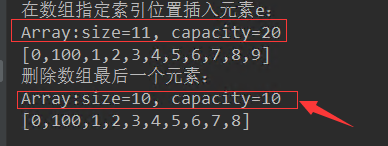Java封裝數(shù)組之動態(tài)數(shù)組實現(xiàn)方法詳解
本文實例講述了Java封裝數(shù)組之動態(tài)數(shù)組實現(xiàn)方法。分享給大家供大家參考,具體如下:
前言:在此之前,我們封裝的數(shù)組屬于靜態(tài)數(shù)組,也即數(shù)組空間固定長度,對于固定長度的數(shù)組當元素超過容量時會報數(shù)組空間不足。為了能更好的使用數(shù)組,我們來實現(xiàn)一個可以自動擴充容量的數(shù)組。
實現(xiàn)思路:
1.當數(shù)組容量達到事先定義值時創(chuàng)建一個空間是data數(shù)組兩倍的newData數(shù)組(擴容);
2.把data數(shù)組中的元素全部賦值到newData數(shù)組中;
3.把data數(shù)組重新執(zhí)行newData數(shù)組。
一、定義核心擴容方法
// 數(shù)組擴容private void resize(int newCapacity){ E[] newData = (E[]) new Object[newCapacity]; for (int i = 0; i < size; i++) {newData[i] = data[i]; } data = newData;}
二、改進之前的數(shù)組添加元素方法(數(shù)組空間不夠時自動擴容 --原理空間的2倍)
//在第index個位置插入一個新元素 public void add(int index, E e) { //(1)判斷當前需要插入值的位置是否合理,合理則轉(zhuǎn)入(3),否則拋出位置不合法異常 if (index < 0 || index > size) throw new IllegalArgumentException('您選擇的位置不合法'); //(2)先判斷當前數(shù)組容量是否已滿,滿則進行容量擴充 if (size == data.length) resize(data.length * 2); //將index位置之后的元素往后依次移動一位 for (int i = size - 1; i >= index; i--) { //(3)將index之后的元素依次往后移動一位,然后將新元素插入到index位置 data[i + 1] = data[i]; } data[index] = e; //(4)維護size值 size++; }
三、改進之前的數(shù)組刪除元素方法(數(shù)組空間空閑太大就會縮容(原來空間的1/2))
//從數(shù)組中刪除index位置的元素,返回刪除的元素 public E remove(int index) { //1.判斷索引的選擇是否合法 if (index < 0 || index > size) throw new IllegalArgumentException('您選擇的位置不合法'); //2.先存儲需要刪除的索引對應(yīng)的值 E ret = data[index]; //將索引為index之后(index)的元素依次向前移動 for (int i = index + 1; i < size; i++) { //3.執(zhí)行刪除--實質(zhì)為索引為index之后(index)的元素依次向前移動,將元素覆蓋 data[i - 1] = data[i]; } //4.維護size變量 size--; // loitering objects != memory leak 手動釋放內(nèi)存空間 data[size] = null; if (size == data.length / 2) { resize(data.length / 2); } //5.返回被刪除的元素 return ret; }
通過以上,我們就可以實現(xiàn)一個動態(tài)的數(shù)組。
測試一下改進后的代碼:
1.測試addLast()
DynamicArray<Integer> arr=new DynamicArray<Integer>(10); for (int i = 0; i < 10; i++) { arr.addLast(i); } System.out.println('添加數(shù)組元素:'); System.out.println(arr);
結(jié)果為:

2.測試add(int index,E e)方法
arr.add(1, 100); System.out.println('在數(shù)組指定索引位置插入元素e:'); System.out.println(arr);
結(jié)果:

現(xiàn)在數(shù)組已經(jīng)從剛才定義的容量為10個變?yōu)榱巳萘繛?0個,數(shù)組中元素為11個,為此實現(xiàn)了數(shù)組擴容。
3.測試removeLast方法
System.out.println('刪除數(shù)組最后一個元素:'); arr.removeLast(); System.out.println(arr);
結(jié)果為:

此時我們可以看出,刪除一個元素之后,數(shù)組容量又從新變?yōu)榱?0個。
本節(jié)所有代碼:
/** * 3.動態(tài)數(shù)組 * 數(shù)組容量可變 */public class DynamicArray<E> { //使用private 的目的是防止用戶從外界修改,造成數(shù)據(jù)不一致 private E[] data; private int size;//數(shù)組中元素個數(shù) //構(gòu)造函數(shù),傳入數(shù)組的容量capacity構(gòu)造Array函數(shù) public DynamicArray(int capacity) { data = (E[]) new Object[capacity];//泛型不能直接實例化 size = 0; } //無參構(gòu)造函數(shù),默認數(shù)組的容量capacity=10 public DynamicArray() { this(10); } //獲取數(shù)組中元素個數(shù) public int getSize() { return size; } //獲取數(shù)組的容量 public int getCapacity() { return data.length; } //獲取數(shù)據(jù)是否為空 public boolean iEmpty() { return size == 0; } //向所有元素后添加元素 public void addLast(E e) { add(size, e);//size表示此時的最后一個元素 } //在所有元素之前添加一個新元素 public void addFirst(E e) { add(0, e);//0表示第一個位置 } //在第index個位置插入一個新元素 public void add(int index, E e) { //(1)判斷當前需要插入值的位置是否合理,合理則轉(zhuǎn)入(3),否則拋出位置不合法異常 if (index < 0 || index > size) throw new IllegalArgumentException('您選擇的位置不合法'); //(2)先判斷當前數(shù)組容量是否已滿,滿則進行容量擴充 if (size == data.length) resize(data.length * 2); //將index位置之后的元素往后依次移動一位 for (int i = size - 1; i >= index; i--) { //(3)將index之后的元素依次往后移動一位,然后將新元素插入到index位置 data[i + 1] = data[i]; } data[index] = e; //(4)維護size值 size++; } //獲取index索引位置的元素 public E get(int index) { //(1)判斷當前需要插入值的位置是否合理,合理則轉(zhuǎn)入(2),否則拋出位置不合法異常 if (index < 0 || index > size) throw new IllegalArgumentException('您選擇的位置不合法'); //(2)返回索引index對應(yīng)的值 return data[index]; } //獲取最后一個元素 public E getLast() { return get(size - 1); } //獲取第一個元素 public E getFirst() { return get(0); } //修改index索引位置的元素為e void set(int index, E e) { //(1)判斷當前需要插入值的位置是否合理,合理則轉(zhuǎn)入(2),否則拋出位置不合法異常 if (index < 0 || index > size) throw new IllegalArgumentException('您選擇的位置不合法'); //(2)修改索引index對應(yīng)的值 data[index] = e; } //查找數(shù)組中是否包含元素e public boolean contains(E e) { for (int i = 0; i < size; i++) { if (data[i] == e)return true; } return false; } //查找數(shù)組中元素e所在的索引(只是一個),如果不存在元素e,則返回-1; public int find(E e) { for (int i = 0; i < size; i++) { if (data[i] == e)return i; } return -1; } //從數(shù)組中刪除index位置的元素,返回刪除的元素 public E remove(int index) { //1.判斷索引的選擇是否合法 if (index < 0 || index > size) throw new IllegalArgumentException('您選擇的位置不合法'); //2.先存儲需要刪除的索引對應(yīng)的值 E ret = data[index]; //將索引為index之后(index)的元素依次向前移動 for (int i = index + 1; i < size; i++) { //3.執(zhí)行刪除--實質(zhì)為索引為index之后(index)的元素依次向前移動,將元素覆蓋 data[i - 1] = data[i]; } //4.維護size變量 size--; // loitering objects != memory leak 手動釋放內(nèi)存空間 data[size] = null; //縮容操作 if (size == data.length / 2 && data.length != 0) { resize(data.length / 4); } //5.返回被刪除的元素 return ret; } //從數(shù)組中刪除第一個元素,返回刪除的元素 public E removeFirst() { return remove(0); } //從數(shù)組中刪除最后一個元素,返回刪除的元素 public E removeLast() { return remove(size - 1); } //從數(shù)組中刪除元素(只是刪除一個) public void removeElement(E e) { int index = find(e); if (index != -1) remove(index); } // 數(shù)組擴容方法 private void resize(int newCapacity) { E[] newData = (E[]) new Object[newCapacity]; for (int i = 0; i < size; i++) { newData[i] = data[i]; } data = newData; } @Override public String toString() { StringBuilder res = new StringBuilder(); res.append(String.format('Array:size=%d, capacity=%dn', size, data.length)); res.append(’[’); for (int i = 0; i < size; i++) { res.append(data[i]); if (i != size - 1) {res.append(','); } } res.append(’]’); return res.toString(); }}
測試代碼:
public class test { public static void main(String[] args) { DynamicArray<Integer> arr=new DynamicArray<Integer>(10); for (int i = 0; i < 10; i++) { arr.addLast(i); } System.out.println('添加數(shù)組元素:'); System.out.println(arr); arr.add(1, 100); System.out.println('在數(shù)組指定索引位置插入元素e:'); System.out.println(arr); System.out.println('刪除數(shù)組最后一個元素:'); arr.removeLast(); System.out.println(arr); }}
更多關(guān)于java相關(guān)內(nèi)容感興趣的讀者可查看本站專題:《Java數(shù)組操作技巧總結(jié)》、《Java字符與字符串操作技巧總結(jié)》、《Java數(shù)學(xué)運算技巧總結(jié)》、《Java數(shù)據(jù)結(jié)構(gòu)與算法教程》及《Java操作DOM節(jié)點技巧總結(jié)》
希望本文所述對大家java程序設(shè)計有所幫助。
相關(guān)文章:
1. 讓chatgpt將html中的圖片轉(zhuǎn)為base64方法示例2. 用xslt+css讓RSS顯示的跟網(wǎng)頁一樣漂亮3. 《CSS3實戰(zhàn)》筆記--漸變設(shè)計(一)4. ASP.NET Core自定義中間件的方式詳解5. 移動端HTML5實現(xiàn)拍照功能的兩種方法6. CSS3實現(xiàn)動態(tài)翻牌效果 仿百度貼吧3D翻牌一次動畫特效7. 教你JS更簡單的獲取表單中數(shù)據(jù)(formdata)8. html5手機觸屏touch事件介紹9. ASP.NET MVC把數(shù)據(jù)庫中枚舉項的數(shù)字轉(zhuǎn)換成文字10. 測試模式 - XSL教程 - 5

 網(wǎng)公網(wǎng)安備
網(wǎng)公網(wǎng)安備